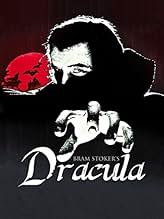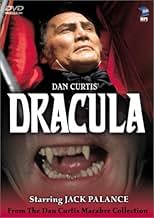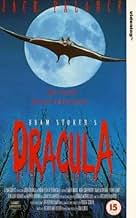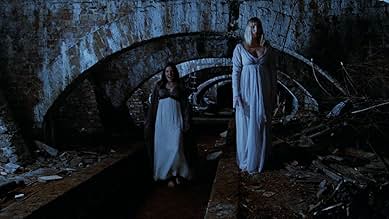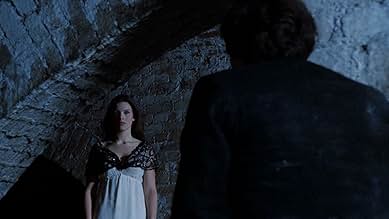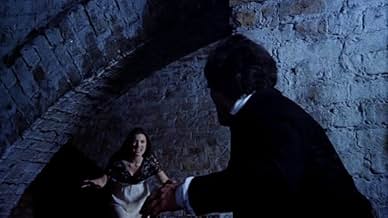IMDb RATING
6.2/10
3.2K
YOUR RATING
Dracula is searching for a woman who looks like his long dead wife.Dracula is searching for a woman who looks like his long dead wife.Dracula is searching for a woman who looks like his long dead wife.
Virginia Wetherell
- Dracula's Wife
- (as Virginia Wetherall)
Hana Maria Pravda
- Innkeeper's Wife
- (as Hanna-Maria Pravda)
- Director
- Writers
- All cast & crew
- Production, box office & more at IMDbPro
Featured reviews
Jack Palance is not the sexiest nor the spookiest Dracula, but he's a marvelous choice for many reasons--and he definitely stands out from the other (often memorable) performances. Only a couple of years before doing this movie, Palance starred in the film THE HORSEMAN, playing a legendary bukashi rider; it was only one of several such horseman-warrior roles Palance specialized in (including the part of Revak in an Italian film titled THE BARBARIANS). In fact, Palance is an actor who can claim to have played both Dracula AND Attila the Hun.
Some might wonder what that has do with the bloodsucking count, but at one point in the Stoker novel, Dracula says, "the blood of Attila flows through these veins." Though they didn't retain that particular line, the film-makers emphasize from beginning to end this particular Dracula is an ex-warrior--and Palance suggests a former, Magyar beserker brilliantly.
This is also the first version of the novel to have the motivation of Dracula travelling to England for the purpose of reclaiming his lost love--an idea that adds a touch of pathos. Perhaps Dan Curtis did simply re-use it from his DARK SHADOWS series, but I can't help but wonder, however, if the idea might also have sprung from this movie's adapter, Richard Matheson. A talented novelist in his own right, Matheson wrote the book (and the screenplay) of SOMEWHERE IN TIME, which also has a central character searching for his true love across the ages. In any case, it's an approach that adds a layer to Dracula's character and would be used again in the Coppola version. I think it will be used in future adaptations as well. In any case, for the record, this was the version that did it first.
All in all, this version isn't as stylish or as atmospheric as some others, but it's well worthwhile and is a must in any Dracula fan's library.
Some might wonder what that has do with the bloodsucking count, but at one point in the Stoker novel, Dracula says, "the blood of Attila flows through these veins." Though they didn't retain that particular line, the film-makers emphasize from beginning to end this particular Dracula is an ex-warrior--and Palance suggests a former, Magyar beserker brilliantly.
This is also the first version of the novel to have the motivation of Dracula travelling to England for the purpose of reclaiming his lost love--an idea that adds a touch of pathos. Perhaps Dan Curtis did simply re-use it from his DARK SHADOWS series, but I can't help but wonder, however, if the idea might also have sprung from this movie's adapter, Richard Matheson. A talented novelist in his own right, Matheson wrote the book (and the screenplay) of SOMEWHERE IN TIME, which also has a central character searching for his true love across the ages. In any case, it's an approach that adds a layer to Dracula's character and would be used again in the Coppola version. I think it will be used in future adaptations as well. In any case, for the record, this was the version that did it first.
All in all, this version isn't as stylish or as atmospheric as some others, but it's well worthwhile and is a must in any Dracula fan's library.
Few people remember that Jack Palance--better known as a rough Western character and elderly machismo cologne huckster--played Dracula. For any 10-11-year-olds in 1973, who saw this TV movie, however, his performance will never be forgotten!
I got a chance to see this version of the classic tale as adult a few years ago and found that it is still a fine film. Palance brings something unique to the vampire role. Somewhere between Max Schreck's hideous rat-like Count Orlok and the debonair Lugosi/Lee/Langela Dracula, Palance may well exude some sort of animal magnetism to women, but is still a hideous fanged beast on the prowl. The scene of him trying to get into the locked hotel room of the two women still gives me shivers. Few Draculas ever barred their fangs and hissed as Palance did--although this has seemed to be a popular move for female vampires.
Jack Palance will never be the first or second (or third) name associated with film vampires. For those who saw him in the role, though, it is hard to ever forget his Dracula. Watch it if you get the chance!
I got a chance to see this version of the classic tale as adult a few years ago and found that it is still a fine film. Palance brings something unique to the vampire role. Somewhere between Max Schreck's hideous rat-like Count Orlok and the debonair Lugosi/Lee/Langela Dracula, Palance may well exude some sort of animal magnetism to women, but is still a hideous fanged beast on the prowl. The scene of him trying to get into the locked hotel room of the two women still gives me shivers. Few Draculas ever barred their fangs and hissed as Palance did--although this has seemed to be a popular move for female vampires.
Jack Palance will never be the first or second (or third) name associated with film vampires. For those who saw him in the role, though, it is hard to ever forget his Dracula. Watch it if you get the chance!
Jonathan Harker (Murray Brown) arrives at Castle Dracula in the Carpathian mountains to assist Count Dracula (Jack Palance) to look for a place in Whitby in Yorkshire. Dracula's motivations are not honest, the real motivation being that Harker's fiancee (Fiona Lewis) is the reincarnation of his long lost dead lover.
A fairly faithful TV movie adaptation with a twist makes for an interesting version of Bram Stoker's classic creation with its interesting added plot device of Lucy being a reincarnation of the Count's lover from the past. On the surface Palance is an interesting choice as the title character, but the plot device of lost love and obsession give Palance's Count an added dimension.
A fairly faithful TV movie adaptation with a twist makes for an interesting version of Bram Stoker's classic creation with its interesting added plot device of Lucy being a reincarnation of the Count's lover from the past. On the surface Palance is an interesting choice as the title character, but the plot device of lost love and obsession give Palance's Count an added dimension.
Other fans of DARK SHADOWS will recognize the lost-love element as having come from Barnabas Collins' tragic situation in that series. It adds a magnificent new element to the Dracula story without diluting the original. Bob Cobert's music, also familiar to DARK SHADOWS fans, is the perfect accompaniment to the tale of the vampire count. I have watched this numerous times since it became available on tape.
The various film adaptations of DRACULA have covered probably most of the ways this can be interpreted, from implied sexual perversion (1931), raw sexuality (HORROR OF DRACULA), flagrant, swept-off-one's-feet romance (1979), to historical retrospective (1992), to modern revisionism (2000). This film takes elements of most of these in a neat TV package with an appropriately British supporting cast.
Watch every version anyway; Dracula is a unique addiction!
The various film adaptations of DRACULA have covered probably most of the ways this can be interpreted, from implied sexual perversion (1931), raw sexuality (HORROR OF DRACULA), flagrant, swept-off-one's-feet romance (1979), to historical retrospective (1992), to modern revisionism (2000). This film takes elements of most of these in a neat TV package with an appropriately British supporting cast.
Watch every version anyway; Dracula is a unique addiction!
MORD39 RATING: *** out of ****
At first glance, Jack Palance would seem to be the wrong type for the lead in this television version of DRACULA; but once the movie is well under way, he is purely magnificent in the role. He admittedly truly got "into" the character, so much so that he sometimes feared he might never be able to get out again!
In the disastrous 1990's we were fed Coppola's BRAM STOKER'S DRACULA, which was a huge disappointment. It stole elements from this 1973 version, most notably the idea of Dracula as a more sympathetic character searching for the reincarnation of his old lover (here she's played by the stunning Fiona Lewis). But the 1992 version failed miserably because we grew to really like Dracula, and that should NEVER happen. But with this Dan Curtis production, we can feel sad for the Count's dilemma, yet still fear and despise him as the villain despite his tragedy. Palance's vampire comes off as a monster, but with just a hint of his past life of humanity which even he seems to miss.
The direction is sound, and the scenery is simple but atmospheric.
To this date, not one version of Stoker's novel has been adapted exactly as he intended it, including this one. There are liberties taken here, but it still remains a better choice than the Coppola film. This is a relatively unseen item that should be re-discovered.
At first glance, Jack Palance would seem to be the wrong type for the lead in this television version of DRACULA; but once the movie is well under way, he is purely magnificent in the role. He admittedly truly got "into" the character, so much so that he sometimes feared he might never be able to get out again!
In the disastrous 1990's we were fed Coppola's BRAM STOKER'S DRACULA, which was a huge disappointment. It stole elements from this 1973 version, most notably the idea of Dracula as a more sympathetic character searching for the reincarnation of his old lover (here she's played by the stunning Fiona Lewis). But the 1992 version failed miserably because we grew to really like Dracula, and that should NEVER happen. But with this Dan Curtis production, we can feel sad for the Count's dilemma, yet still fear and despise him as the villain despite his tragedy. Palance's vampire comes off as a monster, but with just a hint of his past life of humanity which even he seems to miss.
The direction is sound, and the scenery is simple but atmospheric.
To this date, not one version of Stoker's novel has been adapted exactly as he intended it, including this one. There are liberties taken here, but it still remains a better choice than the Coppola film. This is a relatively unseen item that should be re-discovered.
Did you know
- TriviaAccording to the featurette on the DVD, Jack Palance had been offered the role of Dracula several more times after his first performance, but he turned them all down.
- GoofsIn the novel, wolves are frequently mentioned, but in the film, the "wolves" are clearly German Shepherds.
- Alternate versionsTwo versions were created, one for American television and a slightly gorier print for theatrical distribution in Europe. The European version first surfaced on VHS in America in the 1980s hosted by Elvira. In 2002, the TV version was released on DVD by MPI, and they subsequently issued the theatrical version on blu-ray in 2014.
- ConnectionsFeatured in In Search of Dracula with Jonathan Ross (1996)
- What are the differences between the TV Version and the Uncut Version?
Details
- Release date
- Country of origin
- Languages
- Also known as
- Dracula
- Filming locations
- Trakoscan Castle, Croatia(Dracula's castle in long shots)
- Production company
- See more company credits at IMDbPro
Contribute to this page
Suggest an edit or add missing content


